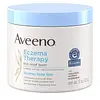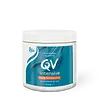What's inside
What's inside
 Key Ingredients
Key Ingredients

 Benefits
Benefits

No benefits
 Concerns
Concerns

 Ingredients Side-by-side
Ingredients Side-by-side

Colloidal Oatmeal 1%
AbsorbentGlycerin
HumectantWater
Skin ConditioningCetearyl Alcohol
EmollientIsocetyl Alcohol
EmollientDimethicone
EmollientCetyl Alcohol
EmollientBenzyl Alcohol
PerfumingEthylhexylglycerin
Skin ConditioningSodium Cetearyl Sulfate
CleansingBenzoic Acid
MaskingStearic Acid
CleansingDipotassium Phosphate
BufferingPotassium Phosphate
BufferingP-Anisic Acid
MaskingCaprylic/Capric Triglyceride
MaskingSodium Hydroxide
BufferingAvena Sativa Kernel Oil
Skin ConditioningCeramide NP
Skin ConditioningCitric Acid
BufferingAvena Sativa Kernel Extract
AbrasiveColloidal Oatmeal 1%, Glycerin, Water, Cetearyl Alcohol, Isocetyl Alcohol, Dimethicone, Cetyl Alcohol, Benzyl Alcohol, Ethylhexylglycerin, Sodium Cetearyl Sulfate, Benzoic Acid, Stearic Acid, Dipotassium Phosphate, Potassium Phosphate, P-Anisic Acid, Caprylic/Capric Triglyceride, Sodium Hydroxide, Avena Sativa Kernel Oil, Ceramide NP, Citric Acid, Avena Sativa Kernel Extract
 Reviews
Reviews

Ingredients Explained
These ingredients are found in both products.
Ingredients higher up in an ingredient list are typically present in a larger amount.
Cetearyl alcohol is a mixture of two fatty alcohols: cetyl alcohol and stearyl alcohol. It is mainly used as an emulsifier. Emulsifiers help prevent the separation of oils and products. Due to its composition, it can also be used to thicken a product or help create foam.
Cetearyl alcohol is an emollient. Emollients help soothe and hydrate the skin by trapping moisture.
Studies show Cetearyl alcohol is non-toxic and non-irritating. The FDA allows products labeled "alcohol-free" to have fatty alcohols.
This ingredient is usually derived from plant oils such as palm, vegetable, or coconut oils. There is debate on whether this ingredient will cause acne.
Due to the fatty acid base, this ingredient may not be Malassezia folliculitis safe.
Learn more about Cetearyl AlcoholDimethicone is a type of synthetic silicone created from natural materials such as quartz.
What it does:
Dimethicone comes in different viscosities:
Depending on the viscosity, dimethicone has different properties.
Ingredients lists don't always show which type is used, so we recommend reaching out to the brand if you have questions about the viscosity.
This ingredient is unlikely to cause irritation because it does not get absorbed into skin. However, people with silicone allergies should be careful about using this ingredient.
Note: Dimethicone may contribute to pilling. This is because it is not oil or water soluble, so pilling may occur when layered with products. When mixed with heavy oils in a formula, the outcome is also quite greasy.
Learn more about Dimethicone